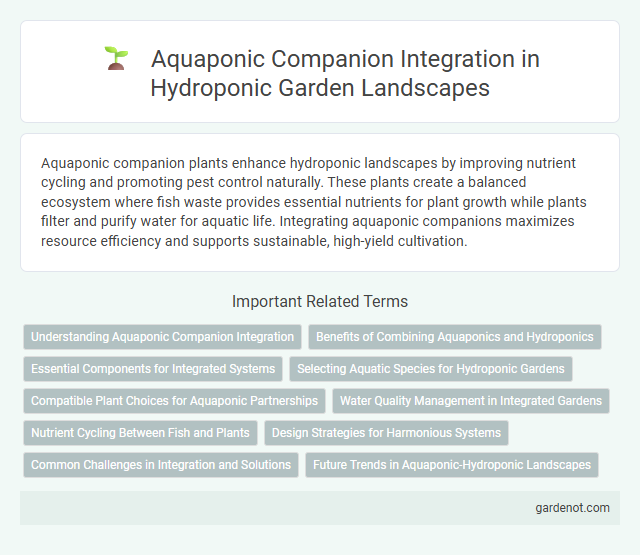Aquaponic companion plants enhance hydroponic landscapes by improving nutrient cycling and promoting pest control naturally. These plants create a balanced ecosystem where fish waste provides essential nutrients for plant growth while plants filter and purify water for aquatic life. Integrating aquaponic companions maximizes resource efficiency and supports sustainable, high-yield cultivation.
Understanding Aquaponic Companion Integration
Aquaponic companion integration combines aquaculture and hydroponics to create a symbiotic environment where fish and plants mutually benefit, enhancing nutrient cycling and water efficiency. By understanding essential parameters such as fish species compatibility, nutrient requirements, and water quality management, operators can optimize growth conditions and system productivity. Effective integration also involves monitoring biofilters and selecting plant species that thrive in aquaponic conditions to maintain a balanced ecosystem.
Benefits of Combining Aquaponics and Hydroponics
Combining aquaponics and hydroponics creates a sustainable ecosystem that optimizes nutrient cycling by using fish waste as a natural fertilizer for plants, reducing the need for synthetic inputs. This integration enhances plant growth rates and crop yields while conserving water through recirculation and reducing environmental impact. The symbiotic relationship between aquatic animals and plants also promotes biodiversity and resilience in controlled environment agriculture systems.
Essential Components for Integrated Systems
Aquaponic companion systems integrate hydroponics and aquaculture by combining fish tanks, grow beds, and biofilters to create a symbiotic environment where fish waste provides nutrients for plants. Key components include a reliable water circulation system, effective biofiltration to convert ammonia into nitrates, and appropriate plant species that thrive in nutrient-rich water. Proper balancing of fish stocking density, plant selection, and water quality monitoring ensures healthy growth and sustainable productivity in integrated aquaponic landscapes.
Selecting Aquatic Species for Hydroponic Gardens
Selecting aquatic species for aquaponic gardens involves prioritizing fish and other aquatic organisms that thrive in controlled water environments and support plant growth through nutrient cycling. Tilapia, catfish, and koi are popular choices due to their hardiness, rapid growth rates, and high waste output, which provides essential nutrients for hydroponic plants. Incorporating species that coexist without stress ensures a balanced ecosystem, enhancing both aquatic health and plant productivity in hydroponic landscapes.
Compatible Plant Choices for Aquaponic Partnerships
Compatible plant choices for aquaponic partnerships include leafy greens like lettuce, spinach, and kale, which thrive in nutrient-rich water and promote efficient nitrogen cycling. Herbs such as basil, mint, and cilantro excel in aquaponic systems due to their rapid growth and pest-repellent properties. Fruiting plants like tomatoes and cucumbers benefit from fish waste nutrients while contributing to balanced water quality in aquaponic setups.
Water Quality Management in Integrated Gardens
Water quality management in aquaponic companion systems is critical for maintaining nutrient balance and fish health in integrated gardens. Monitoring parameters such as pH, ammonia, nitrite, and dissolved oxygen ensures optimal conditions for plant growth and aquatic life sustainability. Implementing biofilters and regular water testing reduces toxin levels and supports a harmonious ecosystem.
Nutrient Cycling Between Fish and Plants
Aquaponic systems harness nutrient cycling by utilizing fish waste as a natural fertilizer for plants, creating a symbiotic environment where plants filter and purify the water for the fish. The conversion of ammonia from fish excretion into nitrates by beneficial bacteria enriches the nutrient profile, promoting healthier plant growth and reducing the need for synthetic fertilizers. Efficient nutrient cycling in aquaponics enhances sustainability and productivity, making it a viable companion technique to hydroponic landscapes.
Design Strategies for Harmonious Systems
Design strategies for harmonious aquaponic companion systems emphasize balanced integration of fish and plants, optimizing nutrient cycling and water quality. Selecting complementary plant species with similar water and nutrient requirements ensures efficient resource use and promotes symbiotic growth. Implementing modular components and adjustable flow rates enhances system scalability and stability for sustainable hydroponic landscape solutions.
Common Challenges in Integration and Solutions
Integrating aquaponic systems with hydroponic landscapes often faces challenges such as nutrient imbalances, water quality management, and maintaining optimal pH levels for both fish and plants. Common solutions include implementing biofilters to stabilize ammonia and nitrite, using automated monitoring systems for real-time water parameter adjustments, and selecting compatible plant and fish species to harmonize ecosystem needs. Regular testing and adaptive management practices ensure sustainable nutrient cycling and overall system health in aquaponic companions.
Future Trends in Aquaponic-Hydroponic Landscapes
Future trends in aquaponic-hydroponic landscapes emphasize integrated systems combining fish farming with soilless plant cultivation to maximize resource efficiency and sustainability. Innovations in sensor technology and automation enable precise nutrient regulation and water recycling, enhancing plant growth and fish health simultaneously. Urban agriculture benefits from vertical and modular designs, promoting scalable solutions for food production in limited spaces.
Aquaponic companion Infographic

 gardenot.com
gardenot.com